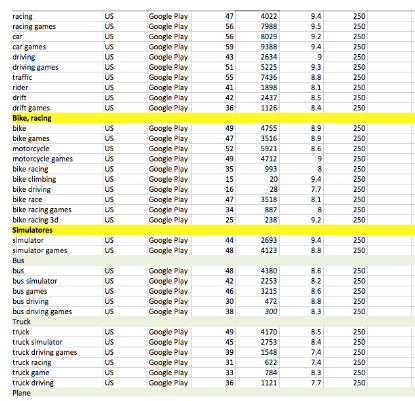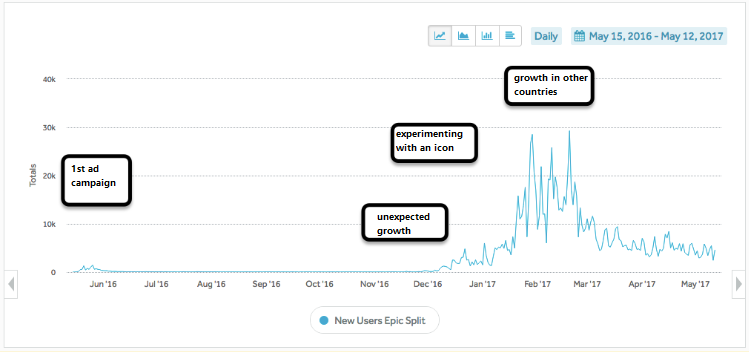A couple of years ago, I wanted to turn my theoretical app store optimization (ASO) knowledge into a working skill.
So I decided to develop a mobile game. My goal was to validate the hypothesis that in the super-competitive mobile gaming market, you can launch a product that will grow into something large solely through organic traffic.
Let me say right away that I did validated this hypothesis: A mobile game we created over the weekend ended up amassing over 2 million downloads, and received over 30,000 new users per day at its peak, all through organic traffic.
But the path to success looked nothing like the original plan.
Here is the story of how the project evolved and how one small change increased the number of downloads by 200%.
→ Test your product management and data skills with this free Growth Skills Assessment Test.
→ Learn data-driven product management in Simulator by GoPractice.
→ Learn growth and realize the maximum potential of your product in Product Growth Simulator.
→ Learn to apply generative AI to create products and automate processes in Generative AI for Product Managers – Mini Simulator.
→ Learn AI/ML through practice by completing four projects around the most common AI problems in AI/ML Simulator for Product Managers.

What product should I create?
I immediately decided that I wanted to make a game. At the time, it had almost been a year since I had quit Zeptolab (the developer of Cut the Rope series, King of Thieves, and CATS) and I really missed the thrill and joy of game development. This was an opportunity to revisit this old hobby.
I spent two weeks identifying and studying popular game niches in app stores. I explored the space, picking out potential competitors with whom I would have to compete for the first place in the search results.

Following my analysis, I decided to build a truck simulator. Without going too much into the details, here are the reasons why I chose this niche.
- It was the niche with a lot of organic traffic, and most importantly, it was growing. Top games were getting millions of downloads per month (I used Sensor Tower for the analysis).
- Even though there were clear leaders in this segment, there were also many apps with more than 100k installs per month, which indicated the games were getting organic traffic in various ways.
- Most games were low-quality and monetized through ads. This meant their users’ lifetime value (LTV) was low, and they could not afford paid user acquisition. This was good news, because I could not afford it either.
- These apps didn’t acquire users through paid ads, and they were not featured in app stores. They survived purely on organic traffic from search and app store recommendations.
Here is an example of one of the most popular truck simulators that was downloaded over 700,000 times within a month on Google Play alone:

The original plan to win organic traffic in the truck simulator niche
Here’s what my initial plan looked like:
1. Make an arcade game about trucks.
2. Launch it on Google Play. Search and recommendations work much better on Google Play than on the Apple App Store, which is why I made this choice for the experiment.
3. Transform theoretical knowledge about ASO into applied skills using $1,000 for the product’s launch and its promotion.
4. Make some money (if I’m lucky).
Here is what actually happened…
Making the game
I made the game with a friend (he wished to remain anonymous, but in many ways, he deserves equal merit for the success of this project). It took us about a week to come up with a concept.
In the end, we decided to make a game based on a famous Volvo commercial. In this ad, Jean-Claude Van Damme did a split on the side windows of two moving trucks. We thought it would be fun for players to try being the driver of the right truck.
The goal of the game was to go as far as possible while keeping Van Damme from falling down. The task was complicated because the left truck acted unpredictably. It could accelerate and switch lanes. The player driving the right truck needed to adapt to the left truck and keep Van Damme standing. The gameplay became challenging when the trucks reached road billboards, because Van Damme had to sit on the splits every time the trucks would go under one of those. It was a casual arcade game with a fun hardcore gameplay that drove some of the players mad.
We developed the game on Unity over a weekend. We spent another week creating the copy and material for the app store, testing on different devices (Android was a real pain), and implementing ad monetization to the game (keeping in mind the paragraph 4 in our plan – “earn some cash if we’re lucky”).
Here’s the trailer of the game:
The game’s launch and “advanced” ASO practices
We launched the game on May 15, 2016. On the day of the launch, there weren’t too many new users aside from us and a couple of friends. It was time to start learning how to get organic traffic through ASO tactics.
Our first target was organic search traffic in the app store. We had $1,000 to outpace our competitors and capture search traffic. I realized there was no chance to win the top keywords right away. Therefore, at the start, we aimed at low- and medium-competition search queries.
A detailed analysis of the semantic core using ASOdesk allowed us to identify three high-priority search queries that had somewhat tolerable competition and just enough traffic.
We used the following process to get to the top ranking for keywords from our target list:
- We changed the name of the game so it would contain the keyword we were competing for. The presence of the search phrase in the title maximized chances to rank high for this keyword in search results.
- We launched an ad campaign in ASOdesk with motivated search traffic (motivated traffic is traffic where users are incentivized to download an app) in order to get a higher ranking for the targeted keyword. The contractors received money for using the specified search query, finding our game and downloading it. This is against Google Play rules, but we deliberately chose this promotion method: Our budget was very limited and we had nothing to lose, thus the risks looked insignificant.
- We acquired motivated traffic in Russia only, but due to the Google Play algorithms, this affected the app’s positions in search results of the targeted keyword in other countries as well.
The promotion campaign for each search keyword lasted several days (depending on the time it took to reach top positions). Some keywords that could be simultaneously placed in the title were promoted together. After reaching the top-three positions for a specific keyword on Google Play, we changed the name of the app, so that a new keyword appeared in it, and then conducted a similar campaign.
At the end of the campaign for the first search keyword, the organic traffic outside Russia reached 40 downloads per day (right Y axis on the graph). After the paired campaign for the second and the third keywords, the downloads outside Russia reached 70 per day, and in Russia itself there were as many as 500.

The red lines mark periods of ad campaigns targeting specific keywords; the blue line shows the number of downloads in Russia (including motivated traffic); the green line is the number of downloads outside Russia (there was no advertising activity there);
If we had more money for the promotion, we could have continued to consistently win more and more high-frequency keywords, while maintaining positions for the old ones.
But due to the limited budget, I decided to go all-in and spend the remaining money on one powerful search query that might have taken the game to the top. This query was “euro truck simulator 2.” This was the name of a popular game that was available on Steam, so people were looking for it in mobile app stores very often, even though it wasn’t there. As part of this campaign, we also promoted the query “euro truck simulator” to influence both search queries.
The bid lost. The game only climbed as high as 7th position in the United States under “euro truck simulator 2” search query and up to the 5th position in “euro truck simulator.” In some other countries, the game landed an even lower position.
We received some organic traffic, but there was no money to support our position in search results for this keyword. Epic Split Truck Simulator’s ranking began to gradually decline in search results for all the keywords we had used. The downloads dropped too.
After a couple of weeks, the game stabilized at 50 downloads per day. We exhausted our entire budget, we earned some experience, and we froze the project. But we still let the game stay in Google Play.
Unexpected twist
The turning point came at the end of November (six months after the launch), when Epic Split suddenly began to grow (mainly in Russia and CIS countries).

Finding out the reason behind the sudden growth was not easy. The app wasn’t featured in the app store, the search query positions remained the same, and the game did not appear in the recommended sections of app store pages of the top apps from the category. And after a brief research, I didn’t find any mention of the game in any tech publication or blog.
To find out where the users came from, I began writing to everyone who left a review, asking them to contact me and tell how and where they learned about the game.
It turned out that the game had somehow found its way into the school kids community (this was evident from the style of the reviews they left). After discovering Epic Split, these kids started to compete and tried to best each other in the game.
Epic Split began to spread through word of mouth. This gave the app a powerful starting push on Google Play, which then helped the game to clinch top positions for relevant search queries in the app store. It also made sure the product was picked up by the app stores’ recommendation systems.
Google Play’s recommended app mechanisms cannot be considered a part of featuring. They are personalized for each user. That’s why it was so difficult to identify them.
Changing the approach for ASO optimization
After finding out the mechanism that helped Epic Split grow, we began to experiment with the game and build on its success. One of the changes we made was to the game’s icon, which had a very unexpected effect on product growth.
On the right is the original icon. On the left is the new icon we designed for the game.

Here’s what happened:
- On January 20, we launched a new icon (left) for 100% of users.
- After that, the number of downloads increased dramatically (almost threefold), and we decided to check whether this had anything to do with the icon or not.
- On January 26, 50% of Google Play visitors were presented with the old icon, while the other 50% saw the new one.
- On January 27, we stopped the experiment because it had a negative effect on the number of downloads.
According to the results of the experiment, it turned out that with the new icon, the conversion to download was 80% higher. But at the same time, the impact on the number of downloads was significantly greater (+200%). Why so?
The number of downloads of the game by days:

The number of downloads of the game by the hours:

The reason was that the main traffic source for Epic Split was coming from the recommendations collection presented on the main page of the app store. The new icon had a higher CTR, and this had an impact on the acquisition funnel on several levels, which had multiple effects:
- Conversion from displaying the app’s icon in the recommendation section into clicking on the recommendation unit on the Google Play homepage increased. As a result, more users came to the app page.
- App page conversion rate also increased thanks to the new icon.
- Consequently, the overall increase in conversion (from being shown in recommendation into download) became equal to the product of improving conversion rates in the two previous steps.
- The above factors caused Google Play to recommend the game more often and rank it higher among recommended apps, since it was more likely to be converted into a download.
So one small change in the icon led to a threefold increase in the number of app downloads.
Building up the success
We continued to engage in ASO optimization of the app page, working on the icon and screenshots. The effect of this work was much greater than direct attempts to win over the top search results.
Over the next month, in almost all the key countries, the page conversion rate of Epic Split became noticeably above the industry average for similar apps. As a result, Google Play continued to expand the pool of users who were shown the game in their recommendations boxes. The growth that started in CIS gradually spread to other countries.
Consequently, the number of downloads increased dramatically. We had over 30,000 new users on our best day. Then for several months, the number of new users stabilized at 5,000 per day, then fell to 1,000, and gradually returned to 100 downloads per day.

The decline was strongly correlated with the decreasing conversion of the app page. I assume that as the game continued to grow, there were fewer and fewer new users who were interested in installing the game. The conversion rate sank, which made Google Play promote the game less.
Summing it up
- Make games over the weekends – sometimes they shoot for the stars. Epic Split had almost 2 million downloads, and the ads monetization helped us rake in over $15k in revenue.
- The game was aimed at a large niche and was unique, which provided it with a sufficiently large target audience. We managed to reach out to this audience through various Google Play mechanisms.
- ASO is not simply about winning search traffic, but also about optimizing all the key steps of a funnel along the user’s path to downloading an app. In this case, the effect of such optimization turned out to be significantly higher than the effect of campaigns targeted at specific search keywords.
- Doing research, exploring the target market and coming up with a marketing plan is a good idea. However, after launching your game, you should be ready to change your plan and act according to new information you obtain. For example, I thought it would be very easy to unseat the dominant truck simulator games from top search results positions. But even in the heat of Epic Split Truck’s wild growth, we found it impossible to get a foothold in the top results.
- Organic traffic and app store optimization must be considered when developing games growth channels. We made a simple arcade game, which had only 15% Day 1 retention rate, and our LTV was less than $0.02 per user. If we had a somewhat decent game with a $0.2 LTV, we could have made good money.
- Marketing is an essential part of building a new product. Keep that in mind.
→ Test your product management and data skills with this free Growth Skills Assessment Test.
→ Learn data-driven product management in Simulator by GoPractice.
→ Learn growth and realize the maximum potential of your product in Product Growth Simulator.
→ Learn to apply generative AI to create products and automate processes in Generative AI for Product Managers – Mini Simulator.
→ Learn AI/ML through practice by completing four projects around the most common AI problems in AI/ML Simulator for Product Managers.






